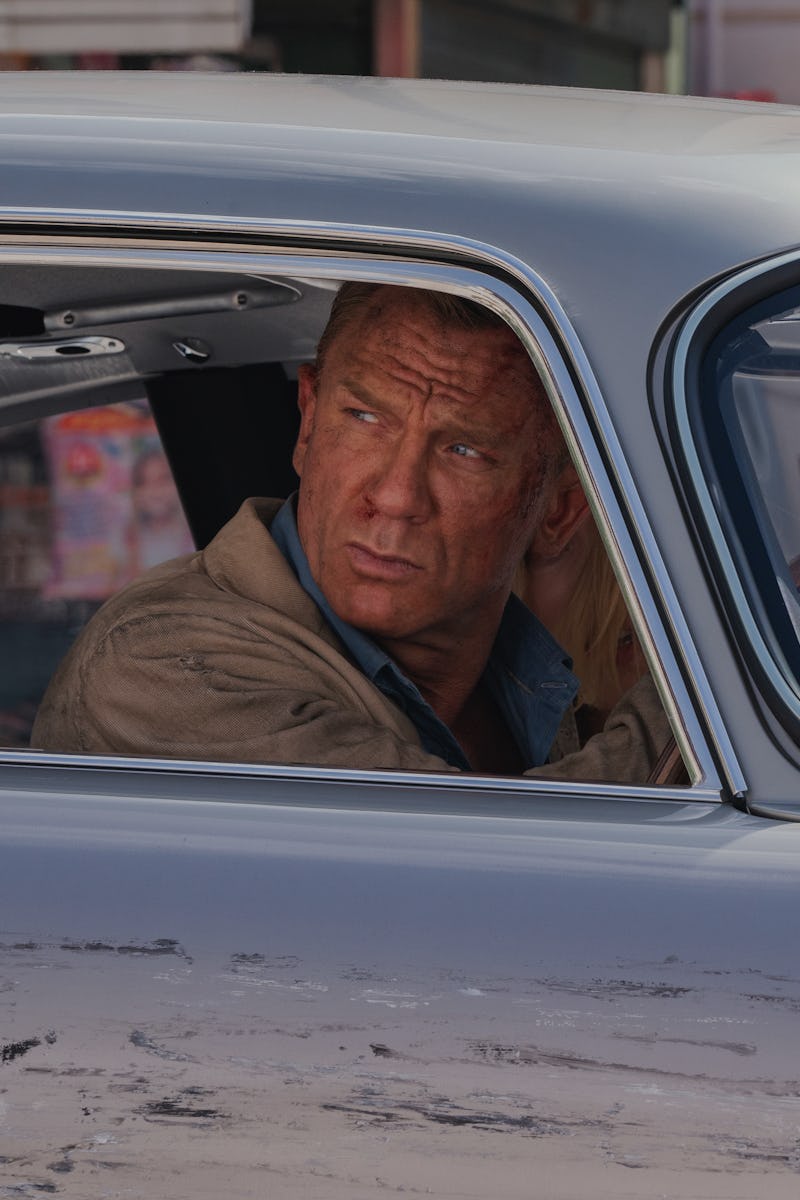
MGM
“We blew it up anyhow.”
Would you lend your car to James Bond? 'No Time to Die' supervisor on 007's Aston Martin
by Eric FranciscoAction-effects veteran Chris Corbould enjoys describing his job at dinner parties. You would to if your job involved designing the Batmobile.
Officially, across everything from this week’s James Bond entry No Time to Die to superhero classics like The Dark Knight, he’s a “special effects and action vehicles supervisor,” which means the death-defying stunts that define these movies are in large part his handiwork.
“Action vehicles and special effects go hand-in-hand,” Corbould tells Inverse. “We’re involved with the stunt people to make sure they’re safe.” And because movies can get fantastical, “We have to be mindful of loading up [cars] with gadgets and special effects we make, install, and operate.”
In other words, Chris Corbould gets to tinker for a living, with cars a movie fan could only dream of driving. He’s been involved with the massively popular James Bond franchise since 1977’s The Spy Who Loved Me, starring Roger Moore.
Since then, Corbould has sustained several eras of Bond, seeing the likes of Pierce Brosnan and Daniel Craig through their respective tenures. He’s also an asset to superhero movies, having worked on X-Men: First Class, Marvel’s upcoming Doctor Strange in the Multiverse of Madness, and Christopher Nolan’s Dark Knight trilogy. (Yes, he worked on the Batmobile.)
The Aston Martin DB5 in use, during filming of No Time to Die.
With No Time to Die, Craig’s final Bond outing, Corbould marks the end of yet another era. The iconic Aston Martin DB5, a staple in the franchise (with a retail price of LOL), is once again driven by Bond in the film, which means Corbould got under its hood. Since first appearing in 1964’s Goldfinger, the swanky vehicle has appeared in Thunderball (1965), GoldenEye (1995), Tomorrow Never Dies (1997), Casino Royale (2006), Skyfall (2012), and SPECTRE (2015).
“The DB5 is recognized as Bond’s personal car,” Corbould says. “I remember in Skyfall there was a big debate [as to whether] the DB5 should get blown up or not. Quite a few people thought it was too big of a character in the film. We didn’t want to lose it.”
After a pause, he adds, “We blew it up anyhow.”
Behind the scenes of No Time to Die, featuring Daniel Craig behind the wheel of the Aston Martin DB5 one last time.
Not to worry, though. The car was rebuilt at the end of SPECTRE, and it’s back with a vengeance in No Time to Die. During one early setpiece, the Aston Martin is tricked out with gadgets and weapons to help Bond extricate himself from a rather sticky situation.
Corbould says filmmakers asked Aston Martin for 10 DB5s. But with each vehicle priced out at $1-2 million, securing so many was impossible. Renting them was also out of the question — at least from the car manufacturer’s end.
After all, jokes Corbould, “Would you rent your car to a James Bond action sequence?”
Ultimately, two original Aston Martin DB5s were purchased, primarily for shots in which Craig suavely enters and exits the vehicle. The rest of the footage was shot inside replicas that were built custom so the production could pull off “all the wacky stuff.”
Chris Corbould (far left) with one of two Aston Martin DB5 cars used for No Time to Die.
Some replicas were decked out with gadgets, while others were equipped with full rally roll cages, and the team could freely “hack them about” without destroying pristine DB5s.
Filmmakers weren’t initially sure how much Bond’s go-to vehicle should evolve in time for the film’s high-octane finale.
“There was a big discussion around whether we should stick the original weapons that it had in Goldfinger or if they should be updated,” Corbould says.
During discussions, the action-effects veteran and his team were told to let their imaginations run wild.
“We were dreaming up different gadgets, from drones firing up in the air to parachutes coming out of seating panels,” he explains. “We went through a huge array of options.”
Sean Connery on the Aston Martin DB5, from Goldfinger.
Ultimately, the decision came down to No Time to Die director Cary Joji Fukunaga, who aimed to balance old-school imagineering with new-school realism. What resulted was a sleek evolution of Bond’s most reliable gadgets. Corbould points out one example: the car’s dual mini-guns, a shift from the famous single-barrel that past Bond cars would whip out.
The Craig era of Bond brought the character back down to Earth, but his cars have rarely reflected reality. Inverse asks whether the evolution of the auto industry — which has over time implemented gadgets like GPS, rear-view cameras, and Bluetooth in consumer-grade cars — has influenced Bond vehicles.
“I don’t think they influenced it at all,” Corbould says. “They got GPS, but they don’t have guns and rockets coming.” Point.
Daniel Craig and the DB5, in Skyfall.
That said, Corbould’s well-aware of the ways Bond has modernized over Craig’s installments, since 2006’s Casino Royale.
“Daniel brought a grittiness back to the franchise,” Corbould says. “Pierce was great. [He] had that humor. But when Daniel appeared on the scene in Casino Royale, it brought the franchise back down to ground level. I thought Die Another Day got quite fantastical. They reined it in with Daniel, and we [found] a fantastic earthiness again.”
Final question: Between the Aston Martin DB5 and the Batmobile, which of his films’ larger-than-life vehicles would Corbould drive?
“If I was going out to dinner, it’s the DB5,” Corbould says, thinking this over. “But if I wanted to get somewhere quick, I’ll drive the Batmobile. People tend to get out of the way if they hear that coming.”
No Time to Die is now playing in theaters.
This article was originally published on